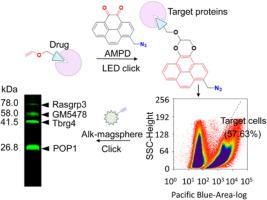当前位置:
X-MOL 学术
›
Chin. Chem. Lett.
›
论文详情
Our official English website, www.x-mol.net, welcomes your
feedback! (Note: you will need to create a separate account there.)
Revealing drug targets with multimodal bioorthogonal AMPD probes through visual metabolic labeling
Chinese Chemical Letters ( IF 9.4 ) Pub Date : 2024-02-13 , DOI: 10.1016/j.cclet.2024.109646 Fukui Shen , Yuqing Zhang , Guoqing Luan , Kaixue Zhang , Zhenzhen Wang , Yunhao Luo , Yuanyuan Hou , Gang Bai
Chinese Chemical Letters ( IF 9.4 ) Pub Date : 2024-02-13 , DOI: 10.1016/j.cclet.2024.109646 Fukui Shen , Yuqing Zhang , Guoqing Luan , Kaixue Zhang , Zhenzhen Wang , Yunhao Luo , Yuanyuan Hou , Gang Bai

|
Multimodal bioorthogonal small molecule probes play a pivotal role in drug-focused biomedical research. However, existing drug tracking and imaging techniques face obstacles in living organisms, hindering precise drug localization and target protein capture. Herein, we introduced a multimodal probe named. 1-(azidomethyl) pyrene-4,5‑dione (AMPD). The probe incorporates adjacent dione structures at the pyrene core. AMPD selectively interacts with oxygen-rich alkene-labeled drug molecules under ice-blue LED light exposure, producing specific fluorescence emission and enabling in vivo tracking and flow cytometry sorting. A methyl azide group was also introduced at the pyrene core to help efficiently enrich target proteins via click chemistry with alkyne-functionalized beads. AMPD demonstrates exceptional biocompatibility, rendering it highly suitable for visual photo-triggered tracking studies. Combined with metabolic labeling using an oxygen-rich alkene-tagged drug molecule probe, AMPD is effective for live animal, tissue, cellular, and in-gel imaging, as well as target protein identification through magnetic capture. With its versatile capabilities, AMPD enhances our comprehension of drug-target interactions at the in vivo level and expedites the process of drug discovery.
中文翻译:

通过视觉代谢标记使用多模式生物正交 AMPD 探针揭示药物靶点
多模态生物正交小分子探针在以药物为重点的生物医学研究中起着关键作用。然而,现有的药物追踪和成像技术在生物体中面临障碍,阻碍了精确的药物定位和靶蛋白捕获。在此,我们介绍了一个名为 .1-(叠氮甲基)芘-4,5-二酮 (AMPD)。探针在芘核处包含相邻的二酮结构。AMPD 在冰蓝色 LED 曝光下选择性地与富氧烯烃标记的药物分子相互作用,产生特异性荧光发射,并实现体内追踪和流式细胞术分选。在芘核心还引入了甲基叠氮化物基团,以帮助通过与炔烃官能化磁珠的点击化学有效富集靶蛋白。AMPD 表现出卓越的生物相容性,使其非常适合视觉光触发跟踪研究。AMPD 与使用富氧烯烃标签药物分子探针的代谢标记相结合,可有效用于活体动物、组织、细胞和凝胶内成像,以及通过磁性捕获进行靶蛋白鉴定。凭借其多功能功能,AMPD 增强了我们在体内水平上对药物-靶标相互作用的理解,并加快了药物发现的过程。
更新日期:2024-02-13
中文翻译:

通过视觉代谢标记使用多模式生物正交 AMPD 探针揭示药物靶点
多模态生物正交小分子探针在以药物为重点的生物医学研究中起着关键作用。然而,现有的药物追踪和成像技术在生物体中面临障碍,阻碍了精确的药物定位和靶蛋白捕获。在此,我们介绍了一个名为 .1-(叠氮甲基)芘-4,5-二酮 (AMPD)。探针在芘核处包含相邻的二酮结构。AMPD 在冰蓝色 LED 曝光下选择性地与富氧烯烃标记的药物分子相互作用,产生特异性荧光发射,并实现体内追踪和流式细胞术分选。在芘核心还引入了甲基叠氮化物基团,以帮助通过与炔烃官能化磁珠的点击化学有效富集靶蛋白。AMPD 表现出卓越的生物相容性,使其非常适合视觉光触发跟踪研究。AMPD 与使用富氧烯烃标签药物分子探针的代谢标记相结合,可有效用于活体动物、组织、细胞和凝胶内成像,以及通过磁性捕获进行靶蛋白鉴定。凭借其多功能功能,AMPD 增强了我们在体内水平上对药物-靶标相互作用的理解,并加快了药物发现的过程。






























 京公网安备 11010802027423号
京公网安备 11010802027423号